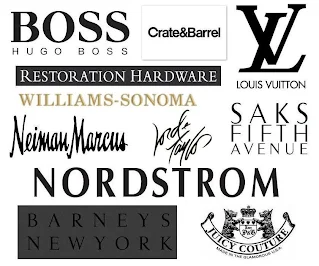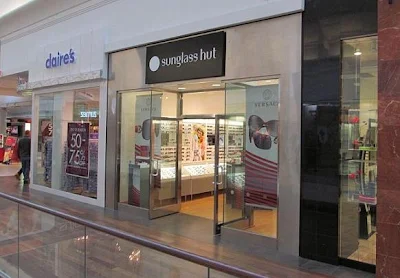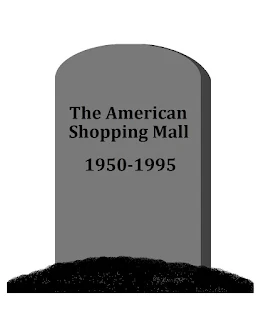DOUGLASS-DESIGNED MALLS 1951-1974:
A list of shopping malls designed by Lathrop Douglass, Senior between the early 1950s and mid-1970s. Those indicated in green have been inducted into the Mall Hall of Fame. Those in blue are on exhibit at the Shopping Mall Museum site.
1. NORTH SHORE SHOPPING MART-THE GARDENS AT GREAT NECK, Nassau County, NY (May 1951)
2. LEVITTOWN SHOP-A-RAMA, Bucks County, PA (October 1953-January 2000) *
3. CROSS COUNTY CENTER, Yonkers, NY (April 1954)
4. MID-ISLAND PLAZA-PLAZA AT MID-ISLAND-BROADWAY MALL-BROADWAY COMMONS, Nassau County, NY (October 1956)
5. BLUE RIDGE CENTER-BLUE RIDGE MALL, Kansas City & Independence, MO (October 1958-January 2003) *
6. PRINCE GEORGES PLAZA-MALL AT PRINCE GEORGES, Hyattsville, MD (November 1958) *
7. CORTEZ PLAZA, Manatee County, FL (February 1959-October 1987) *
8. TOWSON PLAZA, Baltimore County, MD (May 1959) *
9. ROCKLAND CENTRE, Mount Royal, QU (November 1959)
10. WHEATON PLAZA-WESTFIELD SHOPPINGTOWN WHEATON-WESTFIELD WHEATON, Montgomery County, MD (February 1960) *
11. MENLO PARK CENTER-MENLO PARK MALL, Middlesex County, NJ (April 1960)
12. COLONIAL PARK PLAZA-COLONIAL PARK MALL, Dauphin County, PA (June 1960)
13. CONNECTICUT
POST CENTER-CONNECTICUT POST MALL-WESTFIELD SHOPPINGTOWN CONNECTICUT
POST-WESTFIELD CONNECTICUT POST-CONNECTICUT POST MALL, Milford,
Connecticut (September 1960)
14. PHILLIPS HIGHWAY PLAZA-PHILLIPS MALL-MARKET SQUARE-METRO SQUARE OFFICE PARK, Duval County (Jacksonville), FL (November 1960)
15. PARKWAY PLAZA, Orlando, FL (May 1961)
16. REISTERSTOWN ROAD PLAZA-THE PLAZA, Baltimore, MD (March 1962) *
17. EUDOWOOD PLAZA-TOWSON MARKETPLACE-TOWSON PLACE, Baltimore County, MD (August 1962)
18. BOULEVARD MALL, Erie County, NY (November 1962)
19. VESTAL PLAZA-U CLUB BINGHAMTON, Broome County, NY (August 1962)
20. BELTWAY PLAZA-BELTWAY PLAZA MALL, Greenbelt, MD (October 1963)
21. CEDARBROOK MALL-CEDARBROOK PLAZA, Montgomery County, PA (October 1964)
22. FASHION CENTER-FASHION CENTER PARAMUS, Paramus, NJ (February 1967)
23. SOUTHROADS MALL-SOUTHROADS CENTER, Tulsa OK (February 1967) *
24. CHAPEL SQUARE-RESIDENCE COURT (CHAPEL SQUARE MALL), New Haven, CT (March 1967)
25. CHAPEL HILL MALL, Cuyahoga Falls, OH (October 1967-April 2021)
26. LAFAYETTE PLAZA-HI-LO CENTER, Bridgeport, CT (March 1968) *
27. TYSONS CORNER CENTER, Fairfax County, VA (July 1968)
28. PLAZA LAS AMERICAS, San Juan, Puerto Rico (September 1968)
29. MAIN PLACE MALL, Buffalo. NY (October 1968)
30. NORTH MALL-THE CROSSROADS, York County, PA (April 1969)
31. PARLY 2, Le Chesnay, France (November 1969)
32. NORTHWAY MALL-NORTHWAY CENTER, Albany County, NY (October 1970-December 1998)
33. CENTRE COMMERCIAL BELLE EPINE, Thiais, France (September 1971)
34. PARK CITY CENTER, Lancaster, PA (September 1971)
35. EASTVIEW MALL, Ontario County, NY (October 1971) *
36. SUNRISE MALL-WESTFIELD SHOPPINGTOWN SUNRISE-WESTFIELD SUNRISE-SUNRISE MALL, Suffolk County, NY (August 1973-August 2023)
37. CEDONIA MALL, Baltimore, MD (August 1973)
38. OGDENSBURG MALL (open-air pedestrian concourse), Ogdensburg, NY (October 1974)
* Consulting Architect
The Esso Standard Oil Building, in Baton Rouge, was completed in 1950. Douglass-designed Esso office buildings were subsequently built in Elizabeth, New Jersey, Paris, France and Bogata, Columbia.
Photo from Library of Congress
Another international Lathrop Douglass project was the design for Edificio de la Creole, in Caracas, Venezuela. For said design, Douglass won the First Medal Award from the Festival International d'Architecture, in Paris.
Photo from Caracas Cuéntame / Caracas History
One of many freestanding department stores drafted by Lathrop Douglass was the Gimbels Upper Darby unit, at South 69th and Walnut Streets, in Philadelphia. The store and adjacent parking garage were dedicated in September 1957.
Drawing from Gimbels Brothers
In addition to department stores, factories, office buildings and shopping centers, Lathrop Douglass also designed movie theaters; case in point, the Menlo Park Cinema. It opened -in Middlesex County, New Jersey- in October 1961.
Photo from the General Cinema Corporation
The Menlo Park Cinema was an outparcel of the Douglass-designed MENLO PARK CENTER. This open-air mall was officially dedicated in April 1960.
Drawing from Menlo Park Shopping Center, Incorporated
The most celebrated of Lathrop Douglass' Urban Renewal projects redeveloped three city blocks in downtown New Haven. Stores in the CHAPEL SQUARE mall opened in October 1967.

Another Douglass-designed downtown mall was built in Buffalo. Forty MAIN PLACE MALL stores opened their doors in October 1968.
Graphic from the H F & A Development Corporation of New York
Stores in Long Island's SUNRISE MALL opened for business between August and October of 1973. The dual-level, fully-enclosed complex featured four anchor stores and over 100 inline tenant spaces.
Graphic from the Muss-Tankoos Corporation
Sources:
The New York Times
The Kansas City Times (Kansas City, MO)
The Daily Record (Long Branch, NJ)
The Buffalo Courier-Express
The Medina Daily Journal (Medina, NY)
The Farmingdale Observer (Farmingdale, NY)
The Journal (Ogdensburg, NY)
The Herald Mail (Fairport, NY)
The Niagara Falls Gazette
The Transcript-Telegram (Holyoke, MA)
The Reporter Dispatch (White Plains, New York)
The Bridgeport Post (Bridgeport, CT)
Newsday (Nassau Edition)(Hempstead, NY)
Newsday (Suffolk Edition)(Melville, NY)
The Daily Item (Port Chester, NY)
https://antiquarianauctions.com
https://sah-archipedia.org / SAH Archipedia / Karen Kingsley
https://findingaids.library.columbia.edu / Columbia University Archival Collections / "Lathrop Douglass Architectural Drawings, 1955-1973"
ttps://aiahistoricaldirectory / American Institute of Architects / Directory Biographical Section / 1956
https://cinematreasures.org
DOUGLASS MALLS:



























































